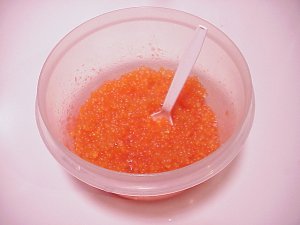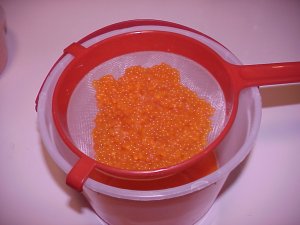Salmon eggs make an extremely effective bait for catching various species of fish. Their strong scent attracts fish from a distance and induces them to strike your lure While you can purchase preserved salmon eggs from tackle shops, learning how to preserve the eggs yourself allows you to control the curing process and save money With just a few simple steps, you’ll be able to preserve salmon eggs at home to create high-quality bait that will stay fresh in your freezer for months.
Obtaining the Eggs
The first step is getting your hands on some salmon eggs. If you catch a female salmon in the fall you can extract the loose skeins of eggs directly from the fish. Handle them very gently to avoid bursting the individual eggs. Another option is to purchase fresh salmon eggs from a fish market or tackle shop during salmon spawning season. Make sure the eggs look plump and are not discolored or mushy.
You can also buy frozen salmon eggs out of season Allow these to thaw overnight in the refrigerator before curing. While frozen eggs will work, fresh ones tend to absorb the cure better
Curing the Eggs
Curing is an essential step for preserving the eggs and adding scent to attract fish. Although you can use salmon eggs right away, curing makes them more durable and improves how they move in the water. The curing process also firms up the eggs so they stay on the hook better.
A basic salmon egg cure contains just salt and borax. The borax helps prevent the eggs from getting mushy. For 1 quart of eggs, a simple cure is:
- 1⁄4 cup salt
- 1⁄4 cup borax
- 1 cup water
Mix these together until fully dissolved. Pour the cure over the eggs and let them soak for about 10 minutes, gently stirring occasionally. The eggs will firm up a bit. Drain off the excess cure liquid and rinse the eggs in fresh water. Allow to drain thoroughly. Repeat the soaking and rinsing 2 more times.
For extra scent, add cured salmon egg juice, anise oil, maple syrup, or ProCure bait scents to the cure. But avoid over-scenting the eggs as too much odor can cause fish to reject the bait.
Freezing the Eggs
To extend their shelf life for the fishing season, freeze cured eggs. Follow these steps:
- Spread eggs in a single layer on a baking sheet and freeze until solid, about 2 hours.
- Transfer to zip-top bags or plastic containers, squeezing out excess air before sealing.
- Label the bags with the egg type and date. Store at 0°F or below.
Proper freezing preserves the texture and scent of the eggs. Thaw frozen eggs overnight in the fridge before using. They’ll keep in the freezer for up to a year.
Making Salmon Egg Sacks
One popular way to fish cured eggs is in small mesh sacks called roe bags. Follow these directions to create homemade salmon egg sacks:
Materials:
- Cured salmon eggs
- Plastic mesh or synthetic sack cloth
- Bait thread
- Small bait floats
Instructions:
- Cut mesh into 2 x 2 inch squares. Place 5-10 eggs in the center.
- Gather the corners around the eggs and pinch them together.
- Wrap bait thread tightly around the top to form the sack. Tie it off.
- Trim excess mesh and add floats if desired.
These durable mini egg sacks float in the current and withstand strikes. Use different sack sizes to match your target species.
Rigging the Eggs
When ready to fish, securely attach the cured eggs to your line using these effective rigging methods:
Egg Loop Knot:
- Thread line through hook eye and bend back parallel to hook.
- Wrap line around shank 8-10 times towards bend.
- Bring end back up through eye.
- Hold end against shank, wrap 8-10 more times.
- Pull end to tighten into loop knot.
- Insert sack and tighten loop around middle.
Salmon Egg Loop Harness:
- Tie on hook 1-3 feet above weight with long tag end.
- Use tag end to tie loop knots every 6-8 inches up line.
- Snell tiny hook on each loop.
- Hook one sack on each snelled hook.
The dropper loops let the eggs drift naturally above the weight.
Getting the Most from Your Bait
Follow these tips to maximize your preserved salmon eggs:
- Check rigs often for damaged sacks and replace as needed.
- Bring extra cured eggs and sacks in case you lose some.
- Don’t let eggs sit in water too long or they become waterlogged.
- Keep hands scent-free when baiting up.
- Match sack size to fish size. Bigger for large trout, smaller for panfish.
- Try tipping sacks with nightcrawlers or minnows for extra attraction.
Taking the time to properly preserve your salmon eggs results in outstanding bait that catches fish trip after trip. Follow the right freezing, curing, and rigging techniques to get the most out of this fabulous fish catcher. With properly cured and preserved salmon eggs in your arsenal, you’ll be ready to catch your limit on your next fishing adventure.

Start typing and hit Enter
Your shopping bag is empty
Great to have you back!
For the best bait possible cure and preserve only the best salmon and trout eggs. You are wasting your time if you did not properly store the eggs prior to the curing process. You should cure the salmon or trout eggs within 24 hours of catching the fish. The eggs are like poultry eggs or meat you buy at a store will go bad if not kept cool and refrigerated. If possible bleed the fish prior to collecting or removing the the eggs from the fish. The best method is to cut one or two of the gill plates. Blood in the eggs can ruin the eggs in less than an hour if not stored properly. Curing the salmon or trout eggs allows you to store the eggs in the refrigerator for a month or freezer for up to a year.

We collected eggs from a Brown Trout. Blood in the eggs can ruin the eggs in less than an hour if not stored properly. If there is excessive blood mixed with the eggs use river water to gently rinse the eggs. Drain all water. All blood must be removed before curing the eggs. The eggs must then be kept cold.

Step 1: You will need a two large plastic bowls, a plastic spoon, eggs, paper towels, a plastic paint strainer, and a quality salmon egg cure.

Step 2: Drain all fluid from the eggs. If there is any trace of blood, rinse the eggs with distilled or river water. Do not use tap water.

Step 3: Trout Eggs ready for curing.

Step 4: Follow the directions on the product label. Generally you will sprinkle the cure on the eggs. Do not use your hand or a metal spoon.

Step 5: Gently stir the eggs to distribute the salmon egg cure evenly to all the eggs.

Step 6: The eggs now must rest for at least 1/2 hour or more. Follow your cures directions. We usually refrigerate the eggs at this time.

Step 7: During the curing process, fluid will be removed from the eggs.

Step 8: Drain the fluid from the eggs using the plastic paint strainer. Discard the fluid, be careful as with most cures the fluid will stain most items. We use a plastic paint strainer because the curing fluid will ruin metal strainers.

Step 9: Drain the eggs for 5 minutes and stir gently with the plastic spoon during the draining.

Step 10: Gently pour the drained cured salmon or trout eggs on paper towels. Discard the curing fluid carefully it will stain most clothing.

Step 11: After air drying for 10 minutes the eggs will become firm and tacky. Gently spoon the cured eggs into plastic bags.

Step 12: Curing salmon or trout eggs allows storage in the refrigerator for a months or frozen for up to a year.
SALT CURE SALMON EGGS RECIPE
FAQ
FAQ
How do you store salmon eggs for bait?
I’ll wrap them in paper towels and put them in a plastic bag before placing them in the fridge to age for at least a week. if freezing them and storing until next season, I put 4 skeins in a plastic bag and put them in the freezer. Once frozen, I vacuum seal the eggs in the plastic bags.
How long does salmon eggs bait last?
How do you preserve salmon roe?
Traditional roe preservation methods include freezing, drying and fermenting, although freezing is the only recommended modern preservation method for salmon roe caviar.
How to cure and preserve eggs from salmon & trout for bait?
How to cure and preserve eggs from salmon or trout for bait. For the best bait possible cure and preserve only the best salmon and trout eggs. You are wasting your time if you did not properly store the eggs prior to the curing process. You should cure the salmon or trout eggs within 24 hours of catching the fish.
Can you cure salmon eggs?
You don’t need Salmon eggs specifically, you can also cure Steelhead and Trout eggs. But often Chinook, Coho, Sockeye, Pink and Chum Salmon eggs are the most popular eggs for bait. In this video, Cameron Black explains the processes, best practices and what not to do on egg curing. How do you cure salmon eggs?
How do you preserve salmon eggs at home?
With a few simple steps you can preserve salmon eggs at home to create high-quality bait that stays fresh in your freezer for months. The first step is acquiring salmon eggs. If you catch a female salmon in the fall, you can extract the loose skeins of eggs. Handle them gently to avoid bursting the eggs.
Are salmon eggs Good Bait?
Salmon eggs make excellent bait for catching a variety of fish species. Their strong scent attracts fish and induces them to strike. While you can buy preserved salmon eggs at tackle shops learning how to preserve the eggs yourself lets you control the curing process and save money.
How do you preserve a salmon skein?
This allows the curing agent to penetrate evenly. Cut the skein into smaller strips for faster, more consistent curing. Curing preserves salmon eggs for prolonged storage Commercial cures contain borax and salt, which draw moisture out of the eggs through osmosis This firms up the eggs and prevents spoilage.
How do you store salmon & trout eggs?
The best method is to cut one or two of the gill plates. Blood in the eggs can ruin the eggs in less than an hour if not stored properly. Curing the salmon or trout eggs allows you to store the eggs in the refrigerator for a month or freezer for up to a year. We collected eggs from a Brown Trout.
